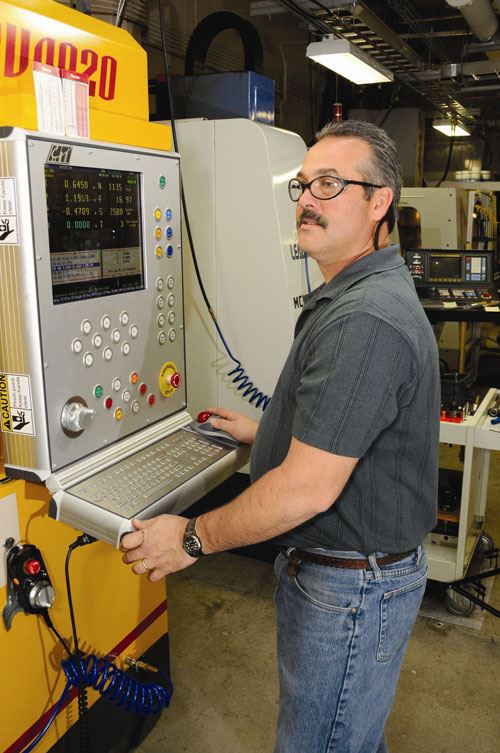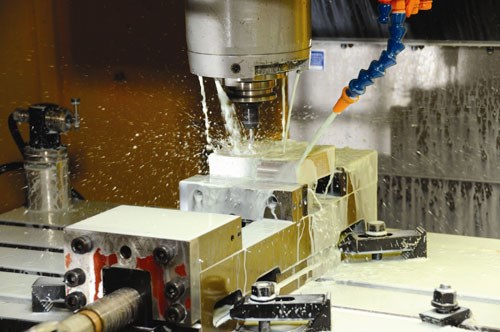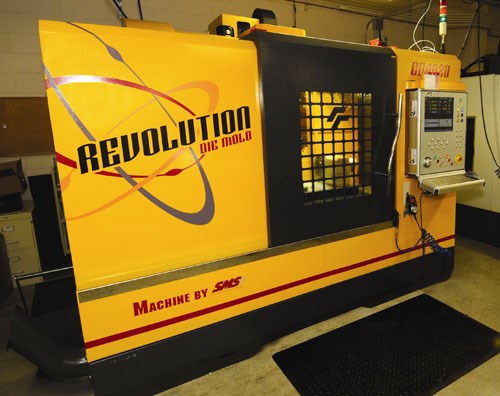Die/Mold Shop Joins Constant Velocity Revolution
According to machine tool supplier GBI Cincinnati, data processing inefficiency inherent in many CNCs can cause actual feeds and speeds to vary significantly from those called for in the part program, leading to acceleration and deceleration during the cut. GBI’s Revolution machine, which features a high speed control designed to keep feeds and speeds closer to programmed rates, has helped this shop significantly improve cycle time and tool life on demanding prototyping applications.
Share


Shops typically take one of two paths for prototyping and die/mold work: EDM or machining. Grinding, 3D imaging and offshoots of EDM have gained some prominence, but one manufacturer says it has taken typical machining processes to a new level. A general-purpose, die/mold VMC equipped with a high speed control has reduced cycle time enough to readily accommodate stringent customer demands for quick turnaround. The key is the control’s 50,000-block-per-second processing speed, which enables the company to avoid the variable feeds and speeds that can result from slower processing of complex part programs.
The machine, a Revolution CV4020 from GBI Cincinnati, was recently installed at W.L. Gore & Associates’ Landenberg, Pennsylvania facility, which is just one of the company’s 45 plants and sales offices worldwide. Founded in 1958 by Wilbert L. and Genevieve Gore, the privately-held firm is headquartered in Newark, Delaware and has 8,000 employees. While the company is most widely known for its Gore-Tex fabric, it also manufactures products used in consumer goods; electronic and electrochemical materials; fibers; geochemical services; cables and cable assemblies; medical products; sealants; and more. Manufacturing operations are clustered primarily in the United States, Germany, Scotland, Japan and China.
The approximately 500 employees at Gore’s 106,000-square-foot Landenberg plant comprise the bulk of the company’s Electronic Products Division. Machinist Ed McCracken says he has done "just about everything" during his time with the company, but he now spends most of his time making dies and molds for the division’s prototype parts. These typically small, complex components incorporate materials ranging from plastics, delron, Teflon, norel and nylon to aluminum and steel. Although many shops may choose to EDM these prototypes—a capability also available at the Gore facility—Mr. McCracken uses the Revolution machine exclusively. "When I can put a part in the VMC, and the finished prototype meets the specified tolerances or better, why would I use another technology?" he asks.
Mr. McCracken says the primary reason for implementing the machine was to improve efficiency and get products to customers as quickly as possible. "This is what customers demand today," he explains. "Everybody wants quick turnaround despite greatly compressed lead times. If you can’t deliver to their expectations, they’ll look elsewhere."
During an evaluation of various VMCs that could help improve delivery time, Mr. McCracken attended the Revolution CV line’s official launch last year at GBI headquarters in Cincinnati, Ohio. One of the first things he noticed was that the machine appeared to be very quiet and stable during a Mercedes test, even with the test block at a 45-degree angle. At an appropriate break, he asked to see the test run on another model that was being set up in the back, away from the main display area. "I was really impressed—the machine wasn’t even leveled up, and it was flawless," he recalls. "That basically sold me on the Revolution."
At W.L. Gore’s Electronic Products Division, the machine has provided not only the short cycle times needed to please customers, but also the quality surface finishes required to successfully produce dies and molds for prototype parts, Mr. McCracken says. This is largely due to the machine’s control, which features a high speed multiprocessor developed by Essex, Ontario-based Miceli Technologies (MTI). While processing speeds on standard controls range from 600 to 3,000 blocks per second, or even 5,000 on higher-end models, the Revolution control can achieve processing speeds of 50,000 blocks per second for eight simultaneously controlled axes, the developer says.
The control’s ability to handle the high volume of data describing tool paths in detail enables the Revolution to achieve "constant velocity" machining, in which the cutting head continuously maintains programmed feeds and speeds. According to the developer, constant velocity along the cutting path eliminates the disruptive acceleration and deceleration often experienced with conventional CNCs as the tool moves through complex contours. These speed variations can result in stress that can dull or even break a cutting tool.
Thus, in addition to providing faster cycle times and quality surface finishes, constant velocity machining has eliminated many of the shop’s previous problems with tool breakage. This was a common occurrence on the shop’s previous machine, especially because the shop uses very small cutting tools, Mr. McCracken says. On average, its end mills measure 0.0625 inch in diameter, and some are as small as 0.01 inch. A cutter measuring 0.125 or 0.25 inch in diameter is considered a large tool at the plant, Mr. McCracken says. Plus, these tiny, thin tools are generally long, ranging from 6 to 10 times the cutter diameter.
He notes that he was "shocked" after successfully using the Revolution to run a 0.01-inch end mill at 12,000 rpm and a 0.1-inch cutting depth through delron. "At that speed and depth, end mills can’t survive changes in the tool path," he says. "But at constant velocity, they can easily handle complex, prismatic work."
Now, tool changes are more often a result of cutters becoming dull rather than breaking, Mr. McCracken says. Nonetheless, regardless of the reason for the tool change, the Revolution control makes the process easier. Able to run any CAD/CAM package that is compatible with a Windows XP environment, the control is said to handle mid-program restart without difficulty. In fact, such restarts can be handled in four different ways: by line number, block number, percentage of program run or by having the operator position the cutter over the workpiece before program start. "When we were using a different machine, going back in the program to the point where the tool broke meant wading through code to find that point," Mr. McCracken says. "We can now go straight in and pick up right where we removed the tool."
The Revolution control has 80 smart data buffers for data transfer, as opposed to the four or five buffers included on most conventional controls, the developer says. While conventional look-ahead systems rely on feedback as the machine operates, the Revolution control calculates look-ahead before the machine starts and adjusts cutter movement as it runs. Its data-processing capability enables it to monitor operations and update tool paths in real time. Additionally, the 50,000-block-per-second processing speed is the minimum when interpolating eight axes—in a three- or four-axis system, the control is even faster.
The machine itself is a Revolution CV4020, a 40-taper VMC with a 15,000-rpm, 20-hp spindle (8,000-, 10,000-, 12,000- and 24,000-rpm models are also available). Other features include a 24-tool magazine and double-arm toolchanger that delivers a 1.9-second chip-to-chip tool change. The X and Y axes feature linear guides, while the Z axis incorporates a boxway design. X-, Y-, and Z-axis travels are 39.4 by 20.5 by 19.9 inches, and rapid traverse rates are 1.417 ipm in the X and Y axes and 1.102 ipm in the Z axis. Positional accuracy is 0.0003 inch, and repeatability is ±0.00012 inch.
Mr. McCracken says the Revolution would make a "great" production machine, and a single one could probably replace a number of conventional VMCs. However, many of its features are not needed for the shop’s prototype parts. "We don’t need all the speed, the very high rpms and a tool change in less than 2 seconds—in fact, we had to dial the ATC down," he explains. "What we do need is the constant velocity, the accuracy, repeatability and the designed-in rigidity and stability. With this single purchase, we’ve slashed prototype times by hours, if not days."
Related Content
Inside a CNC-Machined Gothic Monastery in Wyoming
An inside look into the Carmelite Monks of Wyoming, who are combining centuries-old Gothic architectural principles with modern CNC machining to build a monastery in the mountains of Wyoming.
Read MoreBallbar Testing Benefits Low-Volume Manufacturing
Thanks to ballbar testing with a Renishaw QC20-W, the Autodesk Technology Centers now have more confidence in their machine tools.
Read MoreHow to Determine the Currently Active Work Offset Number
Determining the currently active work offset number is practical when the program zero point is changing between workpieces in a production run.
Read MoreAutomation is for Everyone
Not just for large shops, automation can help even the smallest shops solve labor challenges and become more profitable and efficient.
Read MoreRead Next
OEM Tour Video: Lean Manufacturing for Measurement and Metrology
How can a facility that requires manual work for some long-standing parts be made more efficient? Join us as we look inside The L. S. Starrett Company’s headquarters in Athol, Massachusetts, and see how this long-established OEM is updating its processes.
Read More




















 (1).png;maxWidth=300;quality=90)









